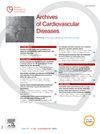Role of a non-coding ZFPM2 locus linked to an increased risk of Brugada syndrome occurrence
IF 2.2
3区 医学
Q2 CARDIAC & CARDIOVASCULAR SYSTEMS
引用次数: 0
Abstract
Introduction
Brugada syndrome (BrS) is a rare inherited cardiac arrhythmia characterized by an increased risk of sudden death due to ventricular arrhythmias originating from the right ventricle (RV) and its outflow tract. Rare genetic variants in SCN5A gene, which generates the main cardiac sodium current (INa), are involved in only 20% of BrS cases. Genome-wide association studies identified strong polygenic influence of specific common risk haplotypes on BrS occurrence. The present study focuses on the risk allele located in an intronic region of ZFPM2 transcription factor gene, known to be involved in cardiac development but which has not been linked so far to the regulation of cardiac electrical activity.
Objective
To study the role of ZFPM2 risk haplotype in cardiac electrical activity using RV cells differentiated from human induced pluripotent stem cells (hiPSCs).
Method
A locus depicting epigenetic characteristics of distal enhancer, and that includes the ZFPM2 risk haplotype, has been identified using both CHIP-seq and ATAC-seq data. This locus has been precisely CRISPR-deleted (i-ZFPM2) in a control (WT) hiPSC line. Both lines were differentiated into RV cells using a cardioid protocol adapted from Schmidt C. et al (Cell, 2023). Gene expression, voltage clamp and current clamp experiments were conducted on differentiated cells.
Results
Differentiated cells displayed a gene expression profile characteristic of RV tissue. In accordance with the hypothesis that the locus is an enhancer, the expression of ZFPM2 was reduced. Interestingly, the expression of SCN5A was also reduced. Accordingly, the i-ZFPM2 RV cells showed a significant reduction of INa as compared to WT (−61%, P < 0.01) with no alteration of biophysical properties of the channel. The amplitude and the dV/dtmax of the action potential were also decreased.
Conclusion
Our results suggest that the investigated region regulates ZFPM2 expression in human RV cells and that ZFPM2 participates in the control of cardiac electrical activity through SCN5A regulation. These data may unveil new mechanisms involved in BrS pathophysiology. Further studies will decipher the precise mechanisms by which this regulation occurs.
非编码ZFPM2位点与Brugada综合征发生风险增加相关的作用
brugada综合征(BrS)是一种罕见的遗传性心律失常,其特征是起源于右心室(RV)及其流出道的室性心律失常导致猝死的风险增加。产生主要心脏钠电流(INa)的SCN5A基因的罕见遗传变异仅与20%的BrS病例有关。全基因组关联研究确定了特定共同风险单倍型对BrS发生的强烈多基因影响。目前的研究重点是位于ZFPM2转录因子基因内含子区域的风险等位基因,已知该等位基因参与心脏发育,但迄今为止尚未将其与心脏电活动的调节联系起来。目的利用人诱导多能干细胞(hiPSCs)分化的RV细胞,研究ZFPM2风险单倍型在心电活动中的作用。方法利用CHIP-seq和ATAC-seq数据确定了描述远端增强子表观遗传特征的位点,包括ZFPM2风险单倍型。该基因座在对照(WT) hiPSC细胞系中被精确地crispr删除(i-ZFPM2)。使用Schmidt C. et al (Cell, 2023)改编的类心细胞方案,将两种细胞系分化为RV细胞。对分化后的细胞进行基因表达、电压箝位和电流箝位实验。结果分化细胞表现出RV组织特有的基因表达谱。根据基因座为增强子的假设,ZFPM2的表达降低。有趣的是,SCN5A的表达也降低了。因此,与WT相比,i-ZFPM2 RV细胞的INa显著减少(- 61%,P <;0.01),通道的生物物理性质没有改变。动作电位的幅值和dV/dtmax也有所降低。结论研究区调控ZFPM2在人RV细胞中的表达,并通过SCN5A调控ZFPM2参与心电活动的调控。这些数据可能揭示BrS病理生理的新机制。进一步的研究将破译这种调控发生的确切机制。
本文章由计算机程序翻译,如有差异,请以英文原文为准。
求助全文
约1分钟内获得全文
求助全文
来源期刊

Archives of Cardiovascular Diseases
医学-心血管系统
CiteScore
4.40
自引率
6.70%
发文量
87
审稿时长
34 days
期刊介绍:
The Journal publishes original peer-reviewed clinical and research articles, epidemiological studies, new methodological clinical approaches, review articles and editorials. Topics covered include coronary artery and valve diseases, interventional and pediatric cardiology, cardiovascular surgery, cardiomyopathy and heart failure, arrhythmias and stimulation, cardiovascular imaging, vascular medicine and hypertension, epidemiology and risk factors, and large multicenter studies. Archives of Cardiovascular Diseases also publishes abstracts of papers presented at the annual sessions of the Journées Européennes de la Société Française de Cardiologie and the guidelines edited by the French Society of Cardiology.
 求助内容:
求助内容: 应助结果提醒方式:
应助结果提醒方式:


